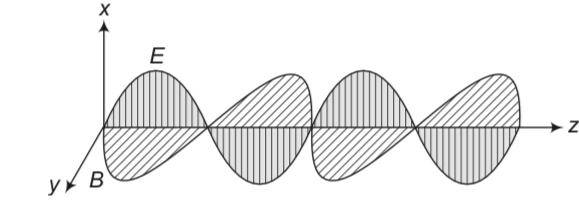Physics Ncert Solutions Class 12th
Get insights from 1.2k questions on Physics Ncert Solutions Class 12th, answered by students, alumni, and experts. You may also ask and answer any question you like about Physics Ncert Solutions Class 12th
Follow Ask QuestionQuestions
Discussions
Active Users
Followers
New answer posted
4 months agoContributor-Level 10
This is a multiple choice answer as classified in NCERT Exemplar
(a, b, c) electromagnetic wave traveling along the z direction is given by
E=E0cos (kz-wt)
The associated magnetic field B in electromagnetic wave is along xaxis along k
B0=E0/c=1/c (k )
E=c (B ) .As the angle is 90 so value is zero.
New answer posted
4 months agoContributor-Level 10
This is a Multiple Choice Questions as classified in NCERT Exemplar
Answer- (a)
Explanation- v=v0i and B =B0j
Force on moving electron F= e (v )
= e (v0i )=-eV0B0k
New answer posted
4 months agoContributor-Level 10
This is a multiple choice answer as classified in NCERT Exemplar
(d) as the electric and magnetic field in electromagnetic wave are perpendicular to each other also they are perpendicular to wave propagation so they are plane polarised.
New answer posted
4 months agoContributor-Level 10
This is a multiple choice answer as classified in NCERT Exemplar
(c) From a diode antenna, the electromagnetic waves are radiated outwards.The amplitude of electric field vector Eo which transports significant energy from the source falls off intensity inversely as the distance from the antenna, i.e. 1/r
New answer posted
4 months agoContributor-Level 10
This is a multiple choice answer as classified in NCERT Exemplar
(c) As from the relation that electric and magnetic energy density are equal to one another so there ratio will be always 1:1
New answer posted
4 months agoContributor-Level 10
This is a multiple choice answer as classified in NCERT Exemplar
(d) The direction of propagation of electromagnetic wave is perpendicular to both electric field vector E and magnetic field vector B, i.e., in the direction of E*B .
This can be seen by the diagram given below

New answer posted
4 months agoContributor-Level 10
This is a multiple choice answer as classified in NCERT Exemplar
(c) E
= =
2= E/
New answer posted
4 months agoContributor-Level 10
This is a multiple choice answer as classified in NCERT Exemplar
(b) as we know momentum = energy transferred/speed of light
= = 36 10-4kgms-1
Momentum of reflected light =0
So momentum delivered is = 36 10-4kgms-1
New answer posted
4 months agoContributor-Level 10
This is a multiple choice answer as classified in NCERT Exemplar
(b) the electromagnetic wave is
Er = Eoicos (kz-wt)
And reflected wave is given by
Er = -E0 (-i)cos (k (-z)+wt+ )
New answer posted
4 months agoContributor-Level 10
This is a multiple choice answer as classified in NCERT Exemplar
(c) E=hv
V= = 2.65 1015hz this belongs to uv region
Taking an Exam? Selecting a College?
Get authentic answers from experts, students and alumni that you won't find anywhere else
Sign Up on ShikshaOn Shiksha, get access to
- 65k Colleges
- 1.2k Exams
- 686k Reviews
- 1800k Answers
